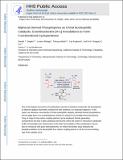| dc.contributor.author | Ziegler, Daniel Todd | |
| dc.contributor.author | Riesgo Canal, Lorena | |
| dc.contributor.author | Ikeda, Takuya | |
| dc.contributor.author | Fujiwara, Yuji | |
| dc.contributor.author | Fu, Gregory C | |
| dc.date.accessioned | 2018-01-26T16:17:35Z | |
| dc.date.available | 2018-01-26T16:17:35Z | |
| dc.date.issued | 2014-11 | |
| dc.date.submitted | 2014-07 | |
| dc.identifier.issn | 1433-7851 | |
| dc.identifier.issn | 1521-3773 | |
| dc.identifier.uri | http://hdl.handle.net/1721.1/113310 | |
| dc.description.abstract | Because of the frequent occurrence of cyclopentane subunits in bioactive compounds, the development of efficient catalytic asymmetric methods for their synthesis is an important objective. Introduced herein is a new family of chiral nucleophilic catalysts, biphenyl-derived phosphepines, and we apply them to an enantioselective variant of a useful [4+1] annulation. A range of one-carbon coupling partners can be employed, thereby generating cyclopentenes which bear a fully substituted stereocenter [either all-carbon or heteroatom-substituted (sulfur and phosphorus)] . Stereocenters at the other four positions of the cyclopentane ring can also be introduced with good stereoselectivity. An initial mechanistic study indicates that phosphine addition to the electrophilic fourcarbon coupling partner is not the turnover-limiting step of the catalytic cycle. | en_US |
| dc.description.sponsorship | National Institutes of Health (U.S.) (Grant R01-GM57034) | en_US |
| dc.publisher | Wiley-Blackwell | en_US |
| dc.relation.isversionof | http://dx.doi.org/10.1002/ANIE.201405854 | en_US |
| dc.rights | Creative Commons Attribution-Noncommercial-Share Alike | en_US |
| dc.rights.uri | http://creativecommons.org/licenses/by-nc-sa/4.0/ | en_US |
| dc.source | PMC | en_US |
| dc.title | Biphenyl-Derived Phosphepines as Chiral Nucleophilic Catalysts: Enantioselective [4+1] Annulations To Form Functionalized Cyclopentenes | en_US |
| dc.type | Article | en_US |
| dc.identifier.citation | Ziegler, Daniel T. et al. “Biphenyl-Derived Phosphepines as Chiral Nucleophilic Catalysts: Enantioselective [4+1] Annulations To Form Functionalized Cyclopentenes.” Angewandte Chemie International Edition 53, no. 48 (October 6, 2014): 13183–13187 © 2014 Wiley-VCH Verlag GmbH & Co. KGaA, Weinheim | en_US |
| dc.contributor.department | Massachusetts Institute of Technology. Department of Chemistry | en_US |
| dc.contributor.mitauthor | Ziegler, Daniel Todd | |
| dc.contributor.mitauthor | Riesgo Canal, Lorena | |
| dc.contributor.mitauthor | Ikeda, Takuya | |
| dc.contributor.mitauthor | Fujiwara, Yuji | |
| dc.contributor.mitauthor | Fu, Gregory C | |
| dc.relation.journal | Angewandte Chemie International Edition | en_US |
| dc.eprint.version | Author's final manuscript | en_US |
| dc.type.uri | http://purl.org/eprint/type/JournalArticle | en_US |
| eprint.status | http://purl.org/eprint/status/PeerReviewed | en_US |
| dc.date.updated | 2018-01-24T15:18:58Z | |
| dspace.orderedauthors | Ziegler, Daniel T.; Riesgo, Lorena; Ikeda, Takuya; Fujiwara, Yuji; Fu, Gregory C. | en_US |
| dspace.embargo.terms | N | en_US |
| mit.license | OPEN_ACCESS_POLICY | en_US |
